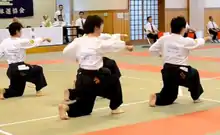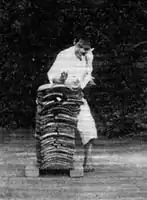Taidō
Taidō[lower-alpha 1] is a Japanese martial art created in 1965 by Seiken Shukumine (1925–2001).[1]. Taidō has its roots in traditional Okinawan karate. Feeling that the martial arts, particularly karate, were not adapting to meet the needs of a changing world, Shukumine first developed a style of karate called Genseiryū around 1950.

Founding

Eventually, Seiken Shukumine became convinced that the limitations of karate lay in its linear mode of training. He considered how to make the defense more flexible and universal and introduced the new art as "Taidō". Taidō's techniques offered many innovations: the inclusion of spinning and twisting movements, gymnastic maneuvers, speedy and effective footwork, and a changing body angle.
Taidō's purpose was, and continues to be, the application of scientific methodology and traditional values to the evolution of the martial arts. According to its creator, Taidō's ultimate aim is to equip its practitioners to function at a high level in society.[2]
Five principles of Taidō
- Keep your mind as clear and calm as the polished surface of a mirror. This way you will see to the heart of things. Having the right state of mind will help you avoid confusion.
- Be composed. Body and mind should be as one. Bear yourself correctly and you need never fear insult.
- Invigorate your spirit from the source of energy deep in your abdomen. With the right spirit you will never fear combat.
- In every action, follow the correct precepts you have been taught. By doing so you cannot act wrongly.
- Be adaptable in your techniques and maintain freedom of physical movement. The right technique will prevent you from being dominated.
Five types of body movements
Taidō classifies attack and defense techniques into five categories of body movement:[3]
- Sen - Vertical spinning movement
- Un - Ascending and descending wave-like movement
- Hen - Falling movement characterized by changing the body's axis
- Nen - Horizontal spinning movement
- Ten - Rolling and tumbling movement
These movements are combined with punches, kicks, and other techniques. The last category, Ten, includes acrobatic movements, for instance back-flips, which makes Taidō spectacular to watch.
Taidō has a special kind of foot-work, which is called unsoku, as well as non-stepping (acrobatic) locomotion, called unshin.
Competition
Competitions in Taidō include Jissen (sparring), Hokei (which is similar to kata), and Tenkai, which is a made-up fight, where one "hero" defeats five opponents during the last part of a 30-second bout. In Tenkai the judges give points to the competing teams in a similar manner as is done in for instance figure skating.
Jissen (Sparring)
Taido is a semi contact sport. A taido match is won the competitor, who is either the first to score a full point (ippon), or has more points when the time ends. A good hit must have proper and legal technique, timing, target, contact and kiai (a shout accompanying the strike). The head is not a valid target. Also, hits must not knock out the other person, but simply indicate the weak point in the opponent's defence.
A kick or a punch is worthy of ippon when it is performed from proper taido movement, has control, lands on the opponent ’s torso and is finally followed by and immediate retraction ad return to one's original position. Failing these, an imperfect hit can however merit a half point (wazari) or a quarter point (yuko).
Warnings are given for improper and bad movement, poor basic stance, wrong target area for strikes or physical damage to the opponent. Typical of a taido match is the constant movement, used for maintaining good distance to the opponent and gaining a feasible offensive position. Turning and twisting moves, acrobatics and shifts in body axes are an integral part of a taido match.
There are no weight classes in taido, because a taidoka must be able to fight against all and any kinds of opponents
Hokei
Movements sets are an inherent part of training in martial arts, and are made up of various basic techniques. They function as a powerful form of basic training, developing both technique, strength, speed and body control. The name for taido's movement sets is hokei.
There are 10 basic hokeis in taido. All of these sets have a basic, prearranged shape and form, but a competitor may change the rhythm and breathing of the hokei as long as the essence of the hokei remains unchanged. A competitor may also receive extra points from the referees, if the difficulty of the hokei is heightened via addition of e.g. somersaults or other moves, not found in the basic version.
The movement sets do not exist only for basic techniques, however, but also for practising combinations and training fighting against imaginary foes. Thus a good form will contain, in addition to good technique, changes in rhythm and features of offence and defence, such as focusing one's eyes on the imagined enemy, movement and production of power. Hokei is an official competition in taido, all the way up to European and World Championship level.
Those who have trained taido for a longer time will also practise hokeis for special techniques and breathing. In all hokeis the result of the match will be determined by three judges, all of whom announce via a raised flag which of the participants won.
Dantai jissen
Dantai jissen, or team sparring, is fought between two teams of five competitors each. Women may have 3-person teams. Matches are played out individually, and the team to accumulate more victories wins.
In dantai jissen the rules and scoring is similar to individual jissen, so a full point (ippon), half point (wazari) and quarter point (yuko) are available, but in addition a single match can also end in a draw, hikiwake.
A kick or a punch is worthy of ippon when it is performed from proper Taido movement, has control, lands on the opponent ’s torso and is finally followed by and immediate retraction ad return to one’s original fighting position. A perfect technique should also include a shout (kiai).
Each team has a team leader. The task of this leader is to draw up the team’s tactics, and based on this to choose the appropriate fighter for each round.
Team training adds variety to one’s regular training. Competing together truly is a part of the art’s appeal. The team to win more individual bouts wins the game.
Dantai hokei
Not many may consider Taido a team sport, although training together is a key part of the art’s appeal. Team hokei is a movement set performed by five competitors at the same time, in as unison as possible.
The intensive training will forge the team a strong and united one. Competitors attempt to maintain their formation from the very beginning as coherently as possible. The movement set must remain within the limits of the area.
The ultimate aim of the team is a performance in perfect unison. The rhythm and breathing in the set can be altered. Also, additional points can be awarded for more difficult techniques not found in the original basic set, such as somersaults.
Grading in team hokei involves, amongst other things, the maintaining of the formation, simultaneousness of the techniques and creativity. Also important are the general impression and the harmony of the set. All of the referees will score the whole hokei, and individual performances within will not be scored separately. The team with the highest score wins. In a tie situation, the head judge’s points will determine the winner.
Team training adds variety to one’s regular training. It also develops team spirit amongst the various trainers.
Tenkai
Tenkai is a prearranged and choreographed, from 25 to 30 seconds long “fight”, in which five persons (wakiyaku) will attack a single central “hero” fighter (shuyaku).
In tenkai both creativity and three-dimensionality are best brought to the stage. The group will design the fight together, which only adds to the team spirit. The timing of the techniques is crucial for the entire fight, and thus merit careful design and much practice. Tenkai thus gives one the opportunity to fully employ the large technique and movement repertoire in taido and also to utilize moves rarely seen in a normal match.
The developer of taido created these team sports to supplement the single ones, since he wanted to emphasize interactivity and sociability amongst the practitioners.
The criteria for points in tenkai include i.a. moving, usage of distance and space, three-dimensionality in both offence and defence, the difficulty of the techniques and the realism and feasibility of the attacks. The central “hero’s” (shuyaku) performance will also be graded with regards to the moves used to finish the tenkai and five attackers. Altogether five judges will be evaluating the activities of the contestants. Furthermore, the main judge will observe the central man and the performance as a whole. The central man must win all the five attackers each at a time. Should the total time either exceed or fall short of the parameters, points will be deducted.
International spread
Taidō is practiced in Japan, Sweden, Finland, Portugal, Denmark, Norway, France, Germany, Great Britain, the Netherlands, Australia, Canada and the United States.
There are an estimated 10,000 to 15,000 Taidoka worldwide, most of them in Japan. In Europe, Finland and Sweden are the countries with the most athletes. The world association, the World Taido Federation, was founded in 1985.
In Finland
Taido first arrived in Finland in Lahti in 1972. It was brought by the Japanese student Minoru Okanda, 2nd dan. He appeared at the Sugata judo exercises in Lahti, after which he asked if people there would like to start practising a new sport.
The first Taidoka were the Judoka of the Lahti Sugata, who were impressed by Okanda's powerful technique and fast movement. Taido was started to be practiced under Genseidojo, which was the Taido section of Lahti Sugata.[4]
The Suomen Taidoliitto (Finnish Taido Association) was founded in 1981, and it operated as the umbrella organization of all Finnish art clubs until 31 December 2013. Since 2011, the Finnish Taido Association was first a member of the Finnish Karate Association, and on 31 December 2013, after the dissolution of the Finnish Taido Association, its member clubs became directly members of the Karate Association as of 1 January 2014. Since then, the former arts association has formed an arts college in the Finnish Karate Association. Taido's sports college acts as a link between all Finnish Taido clubs and as an advocate for the sport in Finland and is called fi:Suomen Taido.[5][6][7]
In Sweden
Taido came to Sweden and outside Japan via Kauko Korhonen who founded the club Taidokan in Stenungsund, which was the first in Sweden / Europe. In Sweden, Taido is organized through the Swedish Budo and Martial Arts Association.[8][9][10][11]
Elsewhere
In Germany, since October 2011 there is an association in Lübeck (Uni-Dojo Zanshin Lübeck).
Taido was established in Norway in 2009. Currently, Halden Taido Club is the only club in Norway.
According to American Taido Association, the presence of Taido in United States is extremely limited, with merely single dojo situated in Dunwoody, Georgia. However, the association is aiming to expand in future.[12][13]
Great Britain too is currently limited to a single dojo situated in Exeter.
Other
Taidō is unrelated to Shintaido. Taidō is also unrelated to Taido 太道 (read by some as 'futoudo').
Yutaka Ozaki studied Taido in his childhood. Novelist Hideo Yokoyama also belonged to Taido Club during his college years.
Notes
- 躰道, meaning "way of the body". Can be romanized as taidō, taido, taidou, taidoh.
References
- Kondo 2004
- Shukumine 1988
- Shukumine 1988
- https://www.taido.fi/yleista-taidosta/lajiesittely/historia/
- http://www.taido.fi/
- http://www.slu.fi/lum/11_06/uutiset/suomen_taidoliitto_30_vuotta/
- https://karateliitto.fi/fi/
- http://www.taido.nu/
- http://www.svensk-taido.se/
- http://www.taido.se/
- http://www.taidokan.se/
- https://taido.net/america/
- http://taido.us/organization/
- Taido Gairon (The Outline of Taido) Japanese, Seiken SHUKUMINE, 1988, ISBN 4-87620-217-6
- Taido Kyohan (Taido Instructions) Japanese, Mitsuo KONDO et al., 2004, Taguchi Printinghous Ltd.
- Taido.net http://taido.net/